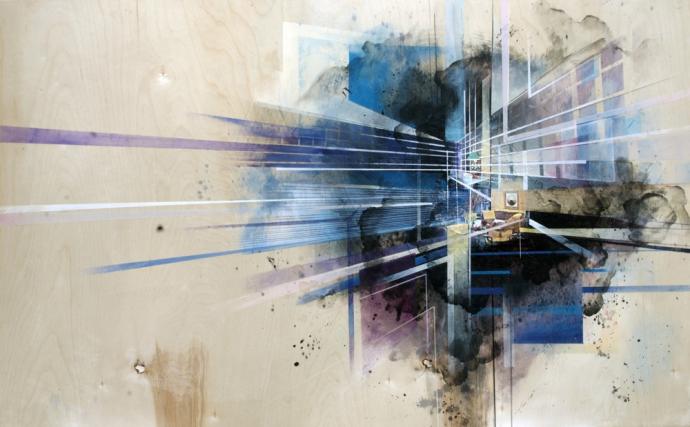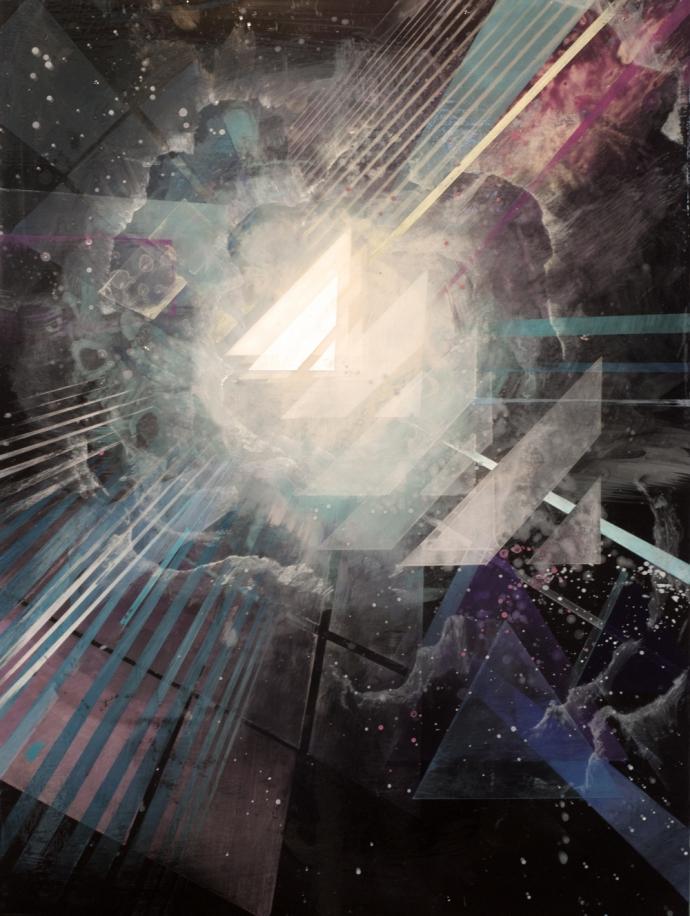from pastelegram.org, June 2011 – April 2014
New Works: Leah Haney
The brochure for Leah Haney's show at the Laguna Gloria Gatehouse Gallery emphasizes the architectural effects present in her work. Indeed, the names of the show's paintings—such as Untitled Space #2, Space Jam #6 and so forth—all reference space both as the final frontier and as the great architectural medium. Haney's pairing of architectural space with its interstellar connotations is not only legible in the works' titles but also in their formal construction. Her paintings of perspectival explosions and geometric supernovae explore the idea of a volatile and nebulous architecture.

Leah Haney, (Untitled) Space, 2012; acrylic and found image on birch panel; 48 in. x 30 in.; courtesy of the artist.
The show consists of two series of paintings—the Untitled Space series and the Space Jam series—and each series contains four works. Haney most obviously differentiates the two series by background: she painted the Untitled Space series atop a raw light-colored wood while the backgrounds of the Space Jam series are black with light star-like points. However, in terms of spatial depiction, the show is in fact divided slightly more specifically. Haney collages five of the works (all four of Untitled Space plus Space Jam #6) with found photographs of conventional domestic interiors such as bathrooms, kitchens and living rooms. The construction of the painting then emanates or explodes from this central origin. Haney finds a variety of geometric elements—such as the linear junctions of walls, ceilings and floors, the grids of bathroom tile, the diagonal rays of sunlight—within each collaged scene and paints their perspective extensions out to the edge of the canvas. These lines erupt outwards, and Haney heightens her works’ explosive effect by enveloping everything in clouds of thick dark smoke.
The effect of these five works is tunnel-like. The lines of extension from the central scenes emphasize perspective and simulate an enclosed spatial experience. Yet the quality of space here is fragmentary and fuzzy. There are no clear walls or overall forms in general. There are only the abstracted elements of form: crisp lines, geometric shape and graduated color. These elements overlap and are translucent. Their translucency implies a clear and bright—though very indirect and refracted—quality of light. The space is prism-like, sparkly and hypnotic. These ideas of space add to the paintings' overall explosive subject matter and to a larger architectural idea of formal dissolution.

Leah Haney, (Untitled) Space Jam, 2012; acrylic on Claybord; 16 in. x 20 in.; courtesy of the artist.
In contrast to these paintings, the three other Space Jam compositions are mostly devoid of perspectival depth. Though Haney composes them similarly with solid polygons and radiating lines, no centrally collaged scene anchors these elements to any perceivable sense of scale or perspective. The lines instead seem to radiate parallel with the canvas plane. The geometric shards explode out of a vast pastel-neon cloud, as if we are viewing distant nebulae through a kaleidoscopic telescope. Architecturally, we are zoomed far out of the previous five spaces in a kind of aerial view. These depictions do not convey spatial experience but rather ideas of surface, structure and overall form. With two of the three (Space Jam #4 and Space Jam #3), Haney describes subtle depth by composing shapes separated by multiple clear coat layers. This slight transparent lift allows the geometric shapes to have physical drop shadows. The gap between these layers becomes the representation of habitable spaces, perhaps those spaces she renders further in the perspective images.
The two series work together to describe a hypothetical architecture conceived as the intersection of the conventionally domestic and the vastly awesome. Haney's nods—through composition and color—to '70s and '80s sci-fi visuals position her work as kin to this design history. Though where Ridley Scott used radiating lines and geometric flares to aestheticize a punk and dystopic police state, Haney's compositions elevate the familiar and comfortable to an uplifting disco high.